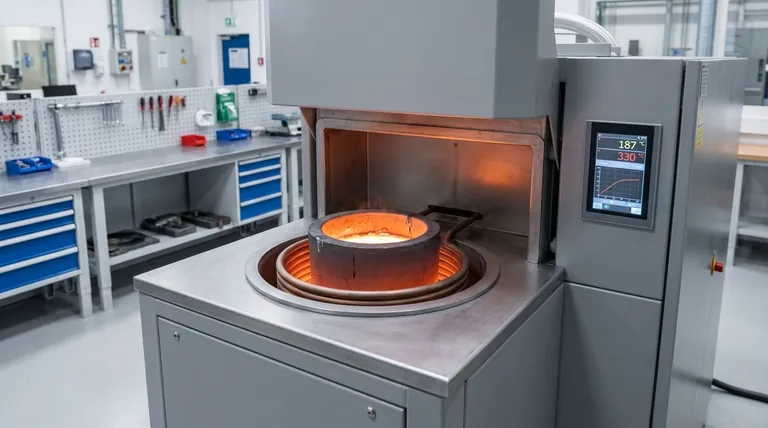For melting aluminum, the most common and effective solution is an induction furnace. This technology is favored across the industry for its exceptional energy efficiency, precise temperature control, and its ability to produce a clean, high-quality melt with minimal material loss.
While other furnace types exist for specialized applications, the induction furnace has become the industry standard for melting aluminum. Its core advantage lies in its clean, contactless heating method, which prevents contamination and ensures the integrity of the final product.

Why Induction Furnaces Dominate Aluminum Melting
An induction furnace doesn't use flames or external heating elements to melt the metal. Instead, it uses the principles of electromagnetism to generate heat directly within the material to be melted, or within its container.
The Principle of Induction Heating
An induction system uses a powerful, high-frequency alternating current passed through a coil. This creates a constantly changing magnetic field around the furnace's crucible.
This magnetic field induces powerful electrical currents, known as eddy currents, within the crucible itself (often made of graphite). The resistance of the crucible to these currents generates intense, rapid heat, which is then transferred to the aluminum, causing it to melt.
Unmatched Purity and Control
Because there is no direct flame contact, the risk of introducing impurities from combustion byproducts into the aluminum is eliminated. This is a critical advantage for producing high-quality alloys.
Furthermore, the process is highly controllable. The amount of heat is directly related to the power supplied to the coil, allowing for very precise and repeatable temperature regulation.
Superior Energy Efficiency
Induction furnaces are highly energy-efficient because the heat is generated exactly where it is needed—in the crucible and the metal charge. Very little energy is wasted heating the surrounding environment, unlike traditional fuel-fired furnaces.
Scalability and Versatility
Induction furnaces are available in a vast range of sizes, making them suitable for everything from small workshops to large-scale industrial foundries.
They are also incredibly versatile, capable of melting not just aluminum but also steel, iron, copper, zinc, and even precious metals like gold and silver.
Understanding the Trade-offs and Limitations
While induction technology is the leading choice, it's essential to understand its operational characteristics and limitations to make an informed decision.
Minimal Metal Refining
A key point to understand is that an induction furnace is primarily a melting device, not a refining one. While it minimizes new contamination, it does little to remove existing impurities from the scrap or raw aluminum being melted.
The Importance of the Crucible
The furnace itself is just one part of the system. A graphite crucible is typically used to hold the aluminum. Graphite is an ideal material because it is a perfect "susceptor"—it readily absorbs the electromagnetic fields and converts them into heat. The crucible is a consumable component and its condition is critical to the process.
Specialized Alternatives Exist
For ultra-high-purity applications or specific research needs, other furnaces may be used. A vacuum furnace, for example, can melt metals in a vacuum to prevent any oxidation. A muffle furnace can also be used to prevent direct flame contact, but induction is generally more efficient for melting.
Making the Right Choice for Your Goal
Selecting the correct furnace ultimately depends on the specific requirements of your operation, including volume, purity standards, and budget.
- If your primary focus is high-volume production and efficiency: An induction furnace is the definitive choice for its unmatched speed, energy efficiency, and scalability.
- If your primary focus is maximum purity for alloys: The clean, contactless heating of an induction furnace is ideal for preventing contamination and ensuring consistent quality.
- If your primary focus is operational control and safety: Induction systems offer precise, automated temperature control and operate without the open flames inherent in fuel-fired furnaces.
Ultimately, choosing an induction furnace provides a modern, controllable, and efficient solution for nearly any aluminum melting requirement.
Summary Table:
| Furnace Type | Primary Use for Aluminum | Key Advantage | Best For |
|---|---|---|---|
| Induction Furnace | Melting | Clean, contactless heating, high efficiency | High-volume production, high-purity alloys |
| Vacuum Furnace | Ultra-high purity melting | Prevents oxidation entirely | Research, specialized alloys |
| Muffle Furnace | Small-scale melting | Prevents direct flame contact | Low-volume, basic applications |
Ready to enhance your aluminum melting process?
KINTEK specializes in high-performance lab equipment, including induction furnaces designed for precise, efficient, and contamination-free melting. Whether you're in a small workshop or a large-scale foundry, our solutions ensure superior results for your aluminum and other metal melting needs.
Contact our experts today to find the perfect furnace for your specific requirements and discover how KINTEK can boost your productivity and product quality.
Visual Guide

Related Products
- 1400℃ Laboratory Quartz Tube Furnace with Alumina Tube Tubular Furnace
- 1700℃ Laboratory Quartz Tube Furnace with Alumina Tube Tubular Furnace
- Vacuum Induction Melting Spinning System Arc Melting Furnace
- Vertical Laboratory Quartz Tube Furnace Tubular Furnace
- 1800℃ Muffle Oven Furnace for Laboratory
People Also Ask
- What material are furnace tubes? Choosing the Right Material for High-Temperature Success
- How does a tubular furnace work? A Guide to Controlled High-Temperature Processing
- What is the high temperature of a tube furnace? Unlock the Right Model for Your Application
- How to clean a tube furnace? A Step-by-Step Guide for Safe and Effective Maintenance
- What is a tube furnace used for? Achieve Precise, Controlled Thermal Processing



















